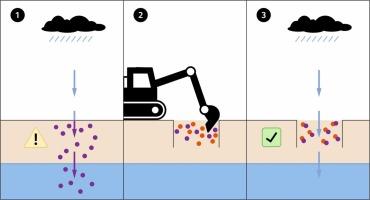使用RemBind®对土壤中全氟烷基和多氟烷基物质进行原位稳定(ISS)的现场演示
IF 11.3
1区 环境科学与生态学
Q1 ENGINEERING, ENVIRONMENTAL
引用次数: 0
摘要
完成了一项实地研究,以评估原位土壤稳定(ISS)在北达科他州骑士空间站的一个前燃烧坑中固定单氟烷基和多氟烷基物质(PFAS)受影响土壤(包括全氟辛烷磺酸(PFOS)和全氟辛酸(PFOA))的有效性。迄今为止,只有少数现场ISS研究发表,这项工作提供了重要的实际考虑和性能数据。根据实验室可处理性研究的结果,RemBind®100X由氢氧化铝/碳混合物(无定形氢氧化铝、高岭石粘土和活性炭)组成,以3%的干重作为稳定材料(或固定剂)应用于受影响的土壤,以减少PFAS从土壤向地下水的浸出。固定剂分布和混合在3英尺的垂直区域,横跨100 × 100英尺的区域,划分为18个测试单元。在19个月的时间里,完成了4个性能监测事件,在此期间,收集土壤样本,使用浸出环境评估框架(LEAF)分析来评估PFAS浸出,并使用井下核磁共振(NMR)成像和原位水分探头来监测渗透带的水分。对于所有分析的PFAS,渗滤液检测后的渗滤液浓度在四个采样事件中每一个都降低了至少95%(±5.1%),并且浓度的测量水平低于美国环境保护署(USEPA)的区域筛选水平(OSD 2023)和全氟辛烷磺酸(PFBA),全氟丁烷磺酸(PFBS),全氟壬烷酸(PFNA),全氟己酸(PFHxA),全氟己磺酸(PFHxS)和六氟环氧丙烷二聚酸(HFPO-DA)。此外,该方法有效地减少了稳定土壤的淋失,同时仍然允许降水入渗。总的来说,本研究证实了该技术的有效性,因此应该在其他类似的受pfas影响的地点加以考虑。本文章由计算机程序翻译,如有差异,请以英文原文为准。

Field Demonstration of In Situ Stabilization (ISS) of Per- and Polyfluoroalkyl Substances in Soil with RemBind®
A field study was completed to assess the effectiveness of in-situ soil stabilization (ISS) to immobilize per- and polyfluoroalkyl substances (PFAS) impacted soil, including perfluorooctanesulfonic acid (PFOS) and perfluorooctanoic acid (PFOA), in a former burn pit at the Cavalier Space Force Station, North Dakota. Only a few field ISS studies have been published to-date and this work provides important practical considerations and performance data. Based on the results of a laboratory treatability study, RemBind® 100X, which consists of an aluminum hydroxide/carbon blend (amorphous aluminum hydroxide, kaolinite clay, and activated carbon), was applied at 3 percent by dry weight as a stabilizing material (or fixant) to impacted soil to reduce PFAS leaching from soil to groundwater. The fixant was distributed and mixed over a 3-foot vertical zone across a 100- x 100-foot area gridded into 18 test cells. Four performance monitoring events were completed throughout 19 months, during which soil samples were collected to assess PFAS leaching using Leaching Environmental Assessment Framework (LEAF) analysis, and vadose zone moisture was monitored using downhole nuclear magnetic resonance (NMR) imaging and in-situ moisture probes. For all PFAS analyzed, leachate concentrations following leachate testing, were reduced by at least 95 percent (±5.1%) for each of the four sampling events and concentrations were measured at levels less than the United States Environmental Protection Agency’s (USEPA’s) regional screening levels (OSD 2023) and maximum contaminant levels (EPA 2024) for PFOS, PFOA, perfluorobutanoic acid (PFBA), perfluorobutanesulfonic acid (PFBS), perfluorononanoic acid (PFNA), perfluorohexanoic acid (PFHxA), perfluorohexanesulfonic acid (PFHxS), and hexafluoropropylene oxide dimer acid (HFPO-DA). Furthermore, the approach was effective at reducing leaching from the stabilized soils, while still allowing infiltration of precipitation. Overall, this study confirms the efficacy of this technology and therefore should be consideration at other similar PFAS-impacted sites.
求助全文
通过发布文献求助,成功后即可免费获取论文全文。
去求助
来源期刊

Journal of Hazardous Materials
工程技术-工程:环境
CiteScore
25.40
自引率
5.90%
发文量
3059
审稿时长
58 days
期刊介绍:
The Journal of Hazardous Materials serves as a global platform for promoting cutting-edge research in the field of Environmental Science and Engineering. Our publication features a wide range of articles, including full-length research papers, review articles, and perspectives, with the aim of enhancing our understanding of the dangers and risks associated with various materials concerning public health and the environment. It is important to note that the term "environmental contaminants" refers specifically to substances that pose hazardous effects through contamination, while excluding those that do not have such impacts on the environment or human health. Moreover, we emphasize the distinction between wastes and hazardous materials in order to provide further clarity on the scope of the journal. We have a keen interest in exploring specific compounds and microbial agents that have adverse effects on the environment.
 求助内容:
求助内容: 应助结果提醒方式:
应助结果提醒方式:


